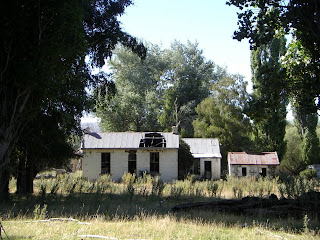Queenstown is the main tourist resort in the South Island but despite that it is still seems 'unspoilt', especially compared with Japan. And the positive side of being at a resort is that there are many activities to do, even on a rainy and overcast day.

Because of the weather Rikas Mum could not to do the bunjee jumping or skydiving, but the next best thing was riding a gondola up the hill to the Skyline restaurant. From the top there a terrific view across Queenstown and down Lake Wakatipu.
And the restaurant served a pretty good breakfast as well.
Next we went to the 'Kiwi Wildlife Park', which is a private nature park where you can see various native New Zealand birds including kiwis. Kiwis are quite cute but they are only active at night, so we could only see them in the gloom of a special darkened hall, and we couldn't take any photos.
The park also put on a bird show and maori culture show. This was a lot more fun and interesting than I expected. This is the presenter with a Tuatara, which is a type of small New Zealand dinosaur. They are called living fossils because they have remained mostly unchanged over the last 220 million years and all their related species have died out millions of years ago.

This is the New Zealand wood-pigeon. My parents often see these in their garden in Dunedin.
And a type of Australian parrot.
I expected the Maori cultural show to be pretty cheesy and sad. But actually it was quite fun as the performers were lively and could really sing.

Hannah especially enjoyed the maori songs. This may be because we often play her a CD of maori songs when we are at home in Tokyo.
Here are some 'keas' which are a native alpine parrot. They are very intelligent birds who normally fly high in the mountains. These ones did not seem very happy to be stuck in a small cage without even a chess set to pass the time.

Queenstown has many many attractions but it seems to be one of the few towns in New Zealand not to have a working steam railway (although there is on at Kingston just 40min drive south). On the other hand they have something even better - a working steam launch, the Earnslaw.

The Earnslaw is not a Hakone-style fake for the tourists. It is a genuine coal-fired steamer which has been working on Lake Wakatipu since 1912. It initially transported goods to sheep-stations around the lake and could carry 1,000 sheep at a time.

We took the evening cruise across to Walter Peak sheep station.
At some point the boat was refurbished for carrying passengers by adding a roof and a bar, and cutting a hole in the deck so we can watch the steam engine working. It really is a lovely piece of technology.
In the evenings we found a really nice, baby-friendly Japanese restaurant called the 'Minami Jijisei' ('southern cross'). It was so nice we went back the second night.


Dad had not been able to hold Hannah much because he had a viral infection but he was able to in the last evening.










































